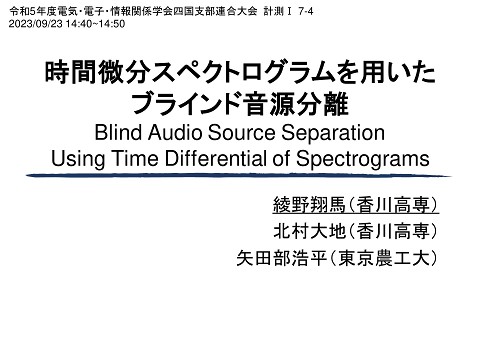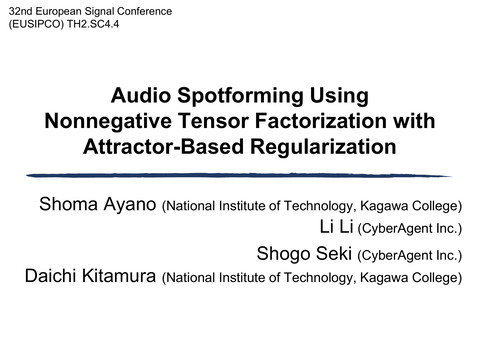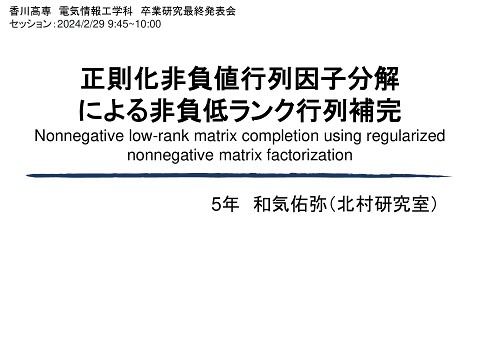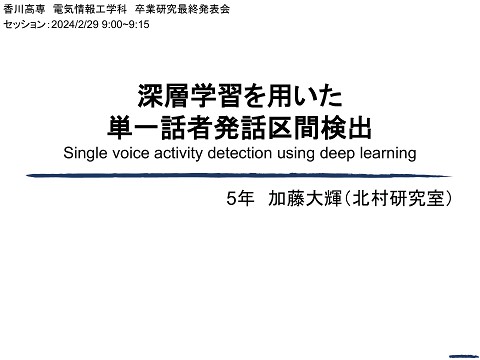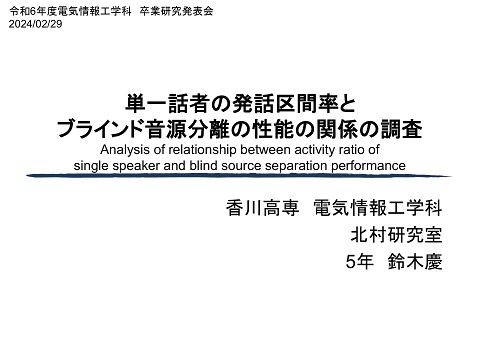Demixing Filter Estimation for Bleeding-Sound Reduction of a Vocal Microphone
>100 Views
October 24, 25
スライド概要
Soushi Taninomiya, Daichi Kitamura, Norihiro Takamune, Kouei Yamaoka, Hiroshi Saruwatari, Yu Takahashi, Kazunobu Kondo, and Hayato Yamakawa, "Demixing filter estimation for bleeding-sound reduction of a vocal microphone," Proceedings of Asia-Pacific Signal and Information Processing Association Annual Summit and Conference (APSIPA ASC 2025), pp. 160–165, Singapore, Singapore, October 2025.
北村研究室の学内・対外発表の発表スライドをまとめています.
関連スライド
各ページのテキスト
17th Asia Pacific Signal and Information Processing Association Annual Summit and Conference Session: D3-1030-L1: Grand Challenge & Audio Processing Time: Thu., 24 Oct., 10:30-12:00 (UTC +7) Demixing Filter Estimation for Bleeding-Sound Reduction of a Vocal Microphone Soushi Taninnomiya , Daichi Kitamura s Norihiro Takamune , Kouei Yamaoka , Hiroshi Saruwatari s Yu Takahashi , Kazunobu Kondo , Hayato Yamakawa s National Institute of Technology, Kagawa College, Japan The University of Tokyo, Japan Yamaha Corporation, Japan
Background • Bleeding sound in live music performances – Non-target sources are also captured, especially by Vo. microphone Drums (Dr.) Bass (Ba.) Ba. amplifier Monitor loudspeaker FoH loudspeaker Monitor loudspeaker Monitor loudspeaker Vocal (Vo.) Guitar (Gt.) Monitor loudspeaker Gt. amplifier FoH loudspeaker We address the problem of reducing the bleeding sound in the Vo. microphone 2
Background • Bleeding sound in live music performances – Non-target sources are also captured, especially by Vo. microphone Drums (Dr.) Close-miking Monitor Ba. loudspeaker amplifier Bass Vocal (Ba.) (Vo.) Guitar Gt. (Gt.) amplifier Monitor loudspeaker FoH loudspeaker Monitor loudspeaker Monitor loudspeaker FoH loudspeaker We address the problem of reducing the bleeding sound in the Vo. microphone 3
Background • Bleeding sound in live music performances – Non-target sources are also captured, especially by Vo. microphone Drums Target source (Dr.) Bleeding sounds from non-target sources Bass (Ba.) Ba. amplifier Monitor loudspeaker FoH loudspeaker Monitor loudspeaker Monitor loudspeaker Vocal (Vo.) Guitar (Gt.) Monitor loudspeaker Gt. amplifier FoH loudspeaker We address the problem of reducing the bleeding sound in the Vo. microphone 4
Conventional method • Bleeding sound reduction problem – is similar to a multichannel audio source separation problem • Blind source separation (BSS) – extracts audio sources from a multichannel mixture – assumes that the mixing system is unknown and estimates the demixing system Source signals Vo. Mixing system Observed signals Demixing system Known Estimate Estimated signals Gt. Ba. Dr. Unknown 5
Conventional method • Independent low-rank matrix analysis (ILRMA) [Kitamura+, 2016] – estimate frequency-wise complex demixing matrix using amplitude and phase information Demixing matrices Time Estimated spectrograms The power spectrogram of each source is modeled by a low-rank matrix Frequency Frequency Frequency Observed spectrograms Channel Tim e Time Update demixing matrices so that estimated signals have low-rank structure in time-frequency domain The microphone are widely spaced Because spatial aliasing occurs, bleeding-sound reduction using ILRMA becomes difficult 6
Proposed method • Characteristics of bleeding sound in live music performances – Vo. microphone contains a large amount of bleeding sound – Other microphones (Gt., Ba., Dr.) contain almost no bleeding sound – These facts have been confirmed through acoustic measurements • Semi-blind model – assumes that microphone signals with little bleeding sound can be treated as the source signals – In live music performances, Gt., Ba., and Dr. microphones serve as references Vo. source Gt. source Ba. source Dr. source Observed signals Vo. microphone Gt. microphone Ba. microphone Dr. microphone 7
Proposed method • Semi-blind ILRMA (proposed method) – Introduce the semi-blind model into ILRMA – Some parameters of the demixing matrix are fixed Normal ILRMA Semi-blind ILRMA Introduce semi-blind model (Gt., Ba., and Dr. are references) Vo. source Vo. microphone Gt. microphone Ba. microphone Dr. microphone Gt. source Ba. source Dr. source The rows of the demixing matrix corresponding to Gt., Ba., and Dr. are fixed as constants Number of parameters to be estimated is reduced, allowing for more stable estimation 8
Bleeding-sound reduction experiment • Experiment overview – Simulate observed signals from impulse responses measured on actual live-music stage – Apply following three methods for bleeding-sound reduction Gamma-TCNMF [Mizobuchi+, 2025] ILRMA Semi-blind ILRMA (proposed) 1.95 m – Compare and evaluate in SDR improvement of Vo. microphone 1.80 m 4.00 m 8.00 m 11.9 m A stage with a height of 0.5 m 0.25 m Ba. 1.00 m 0.95 m 1.80 m Vo. Dr. 4.00 m 1.95 m 1.80 m Gt. 1.00 m 15.8 m 9
Bleeding-sound reduction experiment • Results – 3 dry sources x 30 initializations Conventional methods Proposed method The proposed semi-blind ILRMA clearly outperforms the other methods and achieves significant bleeding-sound reduction 10
Conclusion • Purpose – Reducing the bleeding sound in Vo. microphone • Problem – ILRMA failed to bleeding-sound reduction • Phase information cannot be accurately measured due to spatial aliasing • Proposed method – Focusing on the characteristics of live musical performances • Vo. microphone contains a large amount of bleeding sound • Other microphones (Gt., Ba., Dr.) contain almost no bleeding sound – Introducing a semi-blind model into ILRMA • This model aligns well with the live music performances • Reducing the estimated parameters to ensure stable estimation • Proposed method outperformed conventional methods – Demonstrating the effectiveness of the proposed method using actual measurement data Thank you for your attention. 11

